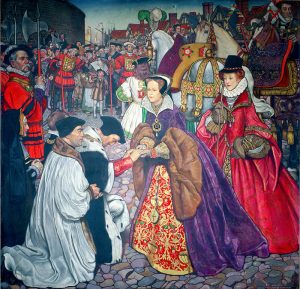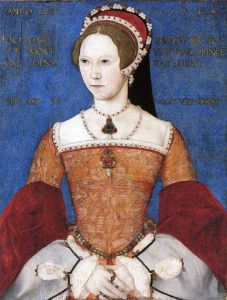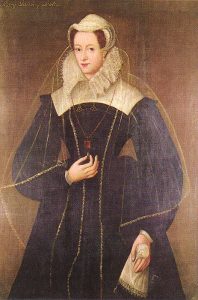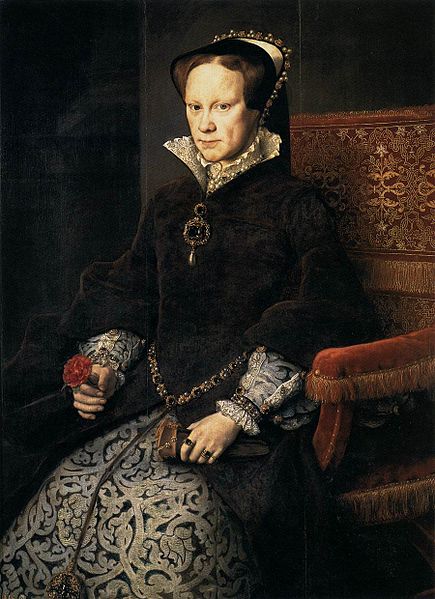The church bells rang throughout the kingdom, and the crowd cheered louder than ever, for they had their one and true Queen, Mary Tudor. The excitement flooded every street in London. They were filled with joy inside about the thought of Mary becoming queen, but they did not necessarily know of the intentions that Mary had for the religion of England. At that very moment, when she was being hailed as England’s new monarch, Mary already knew she was going to bring her very own Catholic faith back to the kingdom. The road to her becoming queen had not been a straight shot like it had been for many others who ascended the throne, but with support, she would get her crown.

Mary was the first daughter of King Henry VIII and his first wife, Catherine of Aragon, and like her parents, she was raised to be a devout Catholic. Henry did not let Mary see her mother anymore after he decided that he was not going to be with Catherine. Henry, desperate to have a son to be his heir, requested from the Pope that he be granted an annulment from Mary’s mother Catherine so that he might marry another woman. The Pope refused to grant Henry the annulment, and he did not take this lightly. He decided that he would make himself the head of the Catholic Church in England, and then, as head of the Anglican Church, grant himself approval to move forward with the annulment. King Henry VIII urged Mary to see him as the head of the church, but she told herself that she would continue to see the Pope as the legitimate head of the entire Catholic church, including that of England. This led to a serious break between the father and daughter. In October of 1533, as Henry’s annulment became effective and he married again, he had Mary declared illegitimate in the line of royal succession, and she was replaced by Elizabeth, Henry’s daughter with his second wife Anne Boleyn. Shortly after Mary lost her mother in 1536, she finally gave up her feud with her father and finally recognized him as the head of the church. With a heavy heart, she knew that one day she would have to make it up to God.1

Just five years later, in October 1537, a son was born to Henry and his third wife, Jane Seymour. You can only imagine how happy Henry was that he finally had a male heir. Little Edward was brought up by Protestant tutors and became close to Henry’s fourth wife, Catherine Parr, who was a Protestant as well. In 1544, Henry had Parliament pass the Act of Succession, which stated that both of his daughters, Mary and Elizabeth, would be in the line of succession behind Edward. This was because Henry’s health problems were worsening. He had contracted malaria at the age of thirty. Although he did not die of it, he nevertheless continued to suffer from its side effects. At about age thirty-six, Henry got varicose ulcers, which are known to be very harsh on the legs. Then, when he was about forty-five, he was injured in a jousting accident that was known to cause horrible damage to his frontal lobe. In his final years, he began to gain weight, causing him to become obese, which raised his blood pressure and gave him diabetes. Thus, knowing that his death was imminent, Henry VIII made his son Edward next in line for the throne, but reestablished the legitimacy of both of his daughters as well.2 When Henry died in January of 1547, Edward became king at the age of nine.
There were multiple changes that little Edward made with the help of his uncle Edward Seymour and many others. He began executing his plans for a thorough reformation of the Anglican Church, with the help of his Archbishop Thomas Cranmer. Archbishop Cranmer taught Edward that Protestantism was to be found in the Scriptures, and religious practice should be based on Scripture. After Edward agreed, Archbishop Cranmer did the assembly that made Edward the new head of the Church of England. In September of 1548, the government finally forbade all preaching throughout England.3 The First Act of Uniformity in 1549 instituted the liturgical use of the Book of Common Prayer. It stated multiple things, including: altars would no longer be used; instead, churches would use simple tables; the mass, based on the theological doctrine of transubstantiation, was replaced with communion, based on the Protestant doctrine of consubstantiation. In 1552, the Second Act of Uniformity was passed in order to make the Book of Common Prayer reflect even more Protestant beliefs and practices. Another Catholic practice that Edward’s reforms touched on was allowing priests to marry. Edward also encouraged Protestant teachings in schools. Things that were no longer allowed in churches were the ringing of the bell, having stained glass windows, or decorations for celebrating Catholic holidays.4 Edward’s reforms were driven by his Protestant advisors and regents, particularly Edward Seymour, Duke of Somerset, and John Dudley, Duke of Northumberland. These changes set a Protestant foundation for the Church of England. Edward’s early death at the age of fifteen meant that he did not see the long-term impact of his reforms, which would be solidified and expanded upon during the reign of his sister, Elizabeth I.
After six years as king, Edward suffered from severe health problems. These health problems resulted in him dying at such a young age. Because he had health problems, he knew that he needed to take care of things so that his eldest half-sister Mary would not become queen. With the help of the Duke of Northumberland, who was also nervous about a Catholic Mary becoming queen, Edward agreed to make Lady Jane Grey, the granddaughter of Henry VII and daughter of Duke of Northumberland, the next monarch. With the Duke’s help, the document “My Device for Succession” made Lady Jane Grey next in line once Edward passed away. In July of 1553, Edward passed away, and the Duke of Northumberland and his supporters claimed Lady Jane Grey as the new monarch. But her reign would only last for nine days.3 A power struggle for the monarchy then ensued between the supporters of Lady Jane Grey and the supporters of Mary. The tide of support quickly turned in Mary’s favor when the public learned of the behind-the-scenes efforts of the Duke of Northumberland to rig things so that his daughter Lady Jane Grey could be queen. This helped Mary’s case because she was seen as the legitimate heir of King Henry VIII.
As the English public cheered at her coronation on October 1, 1553, everyone’s smiles grew bigger and bigger because they had a legitimate Queen. However, what many only feared about Mary, being a Catholic queen, Mary herself knew that she wanted to bring Catholicism back to the realm.6 The first thing that she did was bury her brother Edward VI on August 8, 1553. The next thing she did was gather with Parliament to validate the marriage of her father and mother, Henry and Catherine. She felt that this was essential for her to avenge herself for giving in to her father over the Act of Supremacy and going against the church. Two months after she made her parents’ marriage legal, she did the one thing that her brother was worried about: Mary had Parliament repeal both Acts of Uniformity. All of these changes were big steps in undoing the Protestant movement in England. Mary was able to make changes that would allow for things in the church to go back to the way that they were when her father Henry was king, but she was still not able to restore Catholicism completely. She needed Papal jurisdiction to be reestablished, and she was unable to do that in such a short amount of time.7
Mary’s next step in her campaign to re-catholicize England was to seek a marriage alliance with Spain and the House of Hapsburg. The Spanish Prince Philip was strongly Catholic. On July 25, 1554, after being queen for only a few months, Mary Tudor married Prince Philip. They were married in Winchester Cathedral. She had previously had no intention of ever being married due to the struggles that she saw in her parent’s marriage, but she married Prince Philip to unite England with the fortunes of the house of Hapsburg, the most powerful rulers of Europe, who were also strongly Catholic.8 Many people were against Mary’s marriage, including many in the House of Commons, because they did not like that she would marry a foreigner. They were also afraid that Philip would try to make England a province of the Spanish empire. However, both houses of Parliament ratified their marriage. Throughout their marriage, they are known to have been very respectful to one another. It is also said that Mary was more in love with Philip than he was with her. A few months after they were married, Mary believed that she could be pregnant with their first child. Sadly, as time went by, she noticed that she was not pregnant, her stomach had just been inflamed. Philip ended up traveling a lot during the middle of their marriage, and while he was gone, Mary had another misfortune and was once again not pregnant.9 Philip promised Mary that he would not intervene in any English State affairs, and he kept his promise throughout their marriage. Although he did not get involved in their affairs, he did have a big impact on restoring Catholicism to England.
A combination of factors contributed to what has been called the “Wyatt Rebellion” against Queen Mary in 1554. Many were against her marrying a foreigner, especially a Catholic foreigner. Many were opposed to her campaign to re-Catholicize England. And others were skeptical that a woman should lead their kingdom. These factors all came together under the leadership of Sir Thomas Wyatt, who gathered forces to oppose Mary directly. Once the rebellion began, Mary went around to different towns urging her people to support her. Wyatt and his army were ultimately defeated, with Wyatt and hundreds of his followers being executed. But the Rebellion led to much criticism of Mary, that she had been too gentle with her political enemies who were determined to end her reign. She realized that she needed to take action against those who were seditious. Simon Renard, an advisor to Holy Roman Emperor Charles V, along with Emperor Charles himself, told Mary that if she wanted to become more powerful and get her subjects to obey her, she needed to enact strong laws and enforce those laws. At first, she strongly resisted bringing back the kind of heresy laws her father had once enforced, but soon after the Wyatt Rebellion, she realized that Renard and Emperor Charles were both right and that action needed to be taken. In that same year of 1554, Parliament passed the Act of Repeal, which reinstated those heresy laws.10

Mary faced a problem. What to do about a kingdom that had turned Protestant, but was now officially Catholic? She felt that Protestants were persisting in heresy, and there were severe and final penalties for heresy now on the books. Protestants by the tens of thousands were heretics. Although it was never her official position, Protestants were offered the option of recanting their Protestant beliefs and repenting, or go into exile. If you were a Protestant and were willing to switch to Catholicism, then you were fine, but if you did not, then you would need to face the consequences of being a heretic. Many Protestants began fleeing because they knew that they were no longer safe in Mary’s kingdom.11
It was on February 4, 1555, when everything completely changed for English Protestants. In Smithfield the first Protestant convicted of heresy was killed, John Rogers. Rogers was born in 1505. He was an English Clergyman, bible translator, and commenter. He was imprisoned in 1554 for holding an anti-Catholic protest that warned people of what might come if Mary was brought to reign over England.12 Because of his heretical beliefs, and because he was an influential Protestant leader, he was sentenced to death. As he lay there about to be burned, he was asked once more if he wanted to become Catholic so that he could save himself. Without hesitation, he chose to die proud of being a Protestant. There were many people in the crowd who watched as John Rogers got his life taken away from him. Among the crowd was his beloved wife and eleven children.13 This marked a major turning point for Protestantism in England. John Rogers was the first Protestant martyr of Mary’s reign. After the death of John Rogers, over the next three years, almost three hundred more Protestants were killed, most of them Protestant leaders. The episode in history is known as the Marian persecution. Later, when Protestantism was restored in England, Queen Mary was given the moniker “Bloody Mary” for her role in these deaths.14
Mary Tudor’s efforts to re-Catholicizing England went a long way toward that goal. She made Catholic mass legal, reversed the annulment of her parent’s marriage, passed the repeal of the Act of Uniformity, and brought many Protestants back to Catholicism under the duress of the heresy laws. All of this happened in a matter of six years. But she died without having a successful heir. She is most remembered for the way she dealt with Protestants for resisting her reinstatement of Catholicism. She was ultimately unsuccessful in restoring Catholicism in England because her sister Elizabeth I restored Protestant Christianity soon after Mary passed away.15
I would like to thank my professor Dr. Bradford Whitener for his help in the early stages of this project, particularly in helping me with the approach to take in my research. I am also indebted to Irene Urbina and Dr. Bradford Whitener for their assistance in the editing phase of the project. And I am most grateful to Noemi and Eduardo Pena, Kimberly Alcala, and Marcos Elizondo for their encouragement to help me to see the importance of this project for how it could be helpful and useful to others. It has been a wonderful journey bringing this article to publication, and I appreciate the help and advice of my St. Mary’s team.
- Anthony Ruggiero, “Queen Mary I: Journey to the Throne,” Historic UK, accessed October 28, 2023, https://www.historic-uk.com/HistoryUK/HistoryofEngland/Queen-Mary-I/ Ralph Lewis. ↵
- Claire Ridgway, “The Physical Decline of Henry VIII by Sarah Bryson,” The Tudor Society, accessed October 29, 2023, https://www.tudorsociety.com/the-physical-decline-of-henry-viii-by-sarah-bryson/. ↵
- Jessica Brain, “King Edward VI,” Historic UK, accessed October 29, 2023, https://www.historic-uk.com/HistoryUK/HistoryofEngland/King-Edward-VI/. ↵
- Diramaid MacCulloch, “Parliament and the Reformation of Edward VI (Parliamentary History, 2015), 1. ↵
- Jessica Brain, “King Edward VI,” Historic UK, accessed October 29, 2023, https://www.historic-uk.com/HistoryUK/HistoryofEngland/King-Edward-VI/. ↵
- Eamon Duffy, Fires of Faith: Catholic England under Mary Tudor (Yale University Press, 2009), 15, https://www.jstor.org/stable/j.ctt1npq81. ↵
- John Edwards, A Crown and A Husband (Yale University Press, 2011), 137. ↵
- Jasper Ridley, Bloody Mary’s Martyrs: The Story of England’s Terror (New York: Carroll & Graf Publishers, 2001), 54. ↵
- Amy Licence, “When Mary met Philip: a Tudor queen in love,” History Extra, accessed November 1, 2023, https://www.historyextra.com/period/tudor/philip-ii-spain-mary-tudor-queen-love/. ↵
- Jasper Ridley, Bloody Mary’s Martyrs: The Story of England’s Terror (New York: Carroll & Graf Publishers, 2001), 55. ↵
- Jasper Ridley, Bloody Mary’s Martyrs: The Story of England’s Terror (New York: Carroll & Graf Publishers, 2001), 62. ↵
- Jasper Ridley, Bloody Mary’s Martyrs: The Story of England’s Terror (New York: Carroll & Graf Publishers, 2001), 47. ↵
- Jasper Ridley, Bloody Mary’s Martyrs: The Story of England’s Terror (New York: Carroll & Graf Publishers, 2001), 63. ↵
- Eamon Duffy, Fires of Faith: Catholic England under Mary Tudor (Yale University Press, 2009), 79. ↵
- Jennifer Loach, Mary Tudor and the re-Catholicization of England (Oxford University Press, 1991), 1. ↵




2 comments
Cesia Gonzalez
Such an amazing piece you created! I really enjoyed reading it! I can see the effort you put into it! The structure of your writing has a flow, and it is easy to read! The idea of adding images just made it even better! Great job!
Eduardo Saucedo Moreno
Hello Julianne, Awesome article you have here! I wasn’t very familiar with Mary Tudor but I had heard of her before. I really liked how your images explained the text perfectly as well as made it really easy to understand. What I would have done to this article would’ve been to add one image in the middle of the article because you only use images in the beginning and end. Overall, good job and congrats!